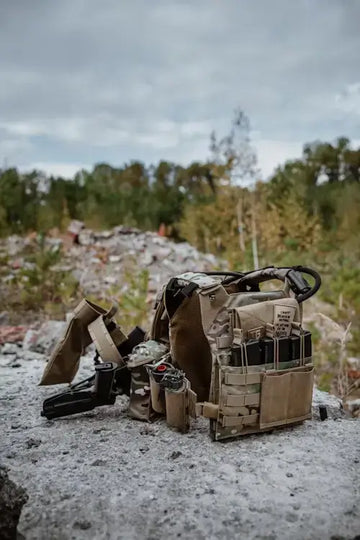Holster Selection Tips for Different Carry Positions
بواسطة Qingyun Qiu على May 29, 2024

Choosing the right holster is crucial for comfort, safety, and accessibility. With so many carry positions available, finding the perfect holster can be overwhelming. Here’s a detailed guide to help you choose a holster for different carry positions, with practical tips and specific considerations.
Inside-the-Waistband (IWB)
IWB holsters are popular for concealed carry. They sit inside your pants, making them easy to hide. When choosing an IWB holster, look for one with a slim profile. This reduces bulk and helps it stay concealed. Comfort is key, so pick a holster with padding or soft materials. Consider the material: leather offers comfort and flexibility, while Kydex provides durability and a precise fit.
Pro Tip: Ensure the holster has a sweat guard to protect your firearm from perspiration and to prevent irritation against your skin.
Outside-the-Waistband (OWB)
OWB holsters are worn outside your pants, often on your belt. They are great for open carry or when concealment isn’t a priority. For OWB holsters, retention is important. Make sure the holster has a secure fit to keep your firearm in place. Look for adjustable retention screws for a customized fit.
Pro Tip: Opt for a pancake-style OWB holster if you need to balance between concealment and accessibility. It hugs closer to the body, reducing the profile under clothing.
Appendix Carry
Appendix carry holsters are at the front of your waistband. This position offers quick access but can be uncomfortable if not chosen correctly. When selecting an appendix carry holster, choose one with adjustable cant (angle). This allows you to find the most comfortable and accessible position. Additionally, a holster with a sweat guard can prevent irritation.
Pro Tip: Look for holsters with built-in wedges or claws that push the grip of the gun closer to your body, enhancing concealment and comfort.

Small of Back (SOB)
SOB holsters are worn at the lower back. They are less common but can be very comfortable. However, they can be difficult to access quickly. When choosing an SOB holster, ensure it has a sturdy clip or belt loop. This keeps the holster securely in place. Consider a padded holster for added comfort during long wear.
Pro Tip: Be cautious of potential back injuries from falling on the firearm if you choose this carry method.
Shoulder Holsters
Shoulder holsters are ideal for those who sit a lot or need to wear a jacket. They distribute the weight of the firearm across your shoulders, reducing strain. When picking a shoulder holster, look for adjustable straps. This ensures a snug fit and prevents the holster from shifting. Also, choose a holster with a retention strap for added security.
Pro Tip: Ensure the shoulder holster has counterbalances like magazine pouches on the opposite side for even weight distribution.

Ankle Holsters
Ankle holsters are perfect for carrying a backup firearm. They are discreet but can be challenging to access quickly. When selecting an ankle holster, look for one with a comfortable and secure strap. Neoprene materials are a good choice for comfort. Make sure the holster has good retention to keep your firearm secure during movement.
Pro Tip: Practice drawing from an ankle holster to ensure you can do so smoothly and quickly when needed.
Pocket Holsters
Pocket holsters are designed for small firearms. They fit inside your pocket, making them very discreet. When choosing a pocket holster, ensure it covers the trigger guard completely. This prevents accidental discharge. Look for a holster with a non-slip exterior to keep it in place when drawing your firearm.
Pro Tip: Use a pocket holster that mimics the shape of common items like a wallet, making the firearm's outline less noticeable.
Cross Draw
Cross draw holsters are worn on the opposite side of your dominant hand, allowing you to draw across your body. They are useful for seated positions and driving. When picking a cross draw holster, consider one with adjustable cant.
This helps find the most natural draw angle. Additionally, choose a holster with strong retention to keep your firearm secure.
Pro Tip: Ensure you practice the cross draw motion regularly, as it can be awkward and requires muscle memory for efficiency.
Drop Leg Holsters
Drop leg holsters, also known as thigh holsters, are popular in tactical environments. They strap to your thigh, keeping your firearm accessible and out of the way of gear on your waist. When choosing a drop leg holster, look for one with adjustable straps to ensure a secure fit. The straps should be padded to prevent chafing and discomfort.
Pro Tip: Ensure the holster has a solid retention system, such as a thumb break or push-button release, to keep your firearm secure during rigorous activities.
Other Considerations
- Material: The material of your holster can significantly impact comfort and durability. Leather holsters conform to your body over time, while Kydex holsters provide a solid, consistent fit. Nylon holsters are lightweight and versatile.
- Retention Mechanisms: Consider holsters with multiple retention levels. Passive retention relies on friction, while active retention includes mechanisms like thumb breaks or retention straps.
- Clothing Compatibility: Ensure your holster fits well with your regular wardrobe. Holsters should be tested with different clothing styles to ensure they remain concealed and comfortable.
- Training: Regularly practice drawing and holstering your firearm from your chosen holster to build muscle memory and ensure smooth, quick access in emergencies.
Wrap-Up
In short, the best holster depends on your carry position and personal preferences. By considering factors like comfort, retention, accessibility, and additional practical tips, you can find a holster that meets your needs. So, experiment with different styles and practice regularly to ensure you’re always prepared.





